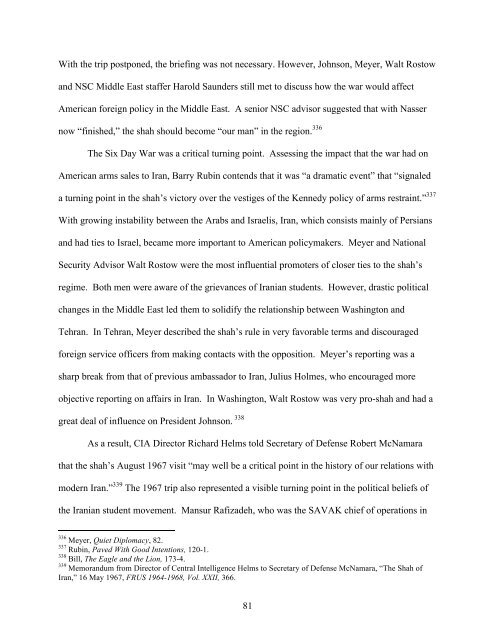AN AUGURY OF REVOLUTION: THE IRANIAN STUDENT ...
AN AUGURY OF REVOLUTION: THE IRANIAN STUDENT ...
AN AUGURY OF REVOLUTION: THE IRANIAN STUDENT ...
Create successful ePaper yourself
Turn your PDF publications into a flip-book with our unique Google optimized e-Paper software.
With the trip postponed, the briefing was not necessary. However, Johnson, Meyer, Walt Rostow<br />
and NSC Middle East staffer Harold Saunders still met to discuss how the war would affect<br />
American foreign policy in the Middle East. A senior NSC advisor suggested that with Nasser<br />
now “finished,” the shah should become “our man” in the region. 336<br />
The Six Day War was a critical turning point. Assessing the impact that the war had on<br />
American arms sales to Iran, Barry Rubin contends that it was “a dramatic event” that “signaled<br />
a turning point in the shah’s victory over the vestiges of the Kennedy policy of arms restraint.” 337<br />
With growing instability between the Arabs and Israelis, Iran, which consists mainly of Persians<br />
and had ties to Israel, became more important to American policymakers. Meyer and National<br />
Security Advisor Walt Rostow were the most influential promoters of closer ties to the shah’s<br />
regime. Both men were aware of the grievances of Iranian students. However, drastic political<br />
changes in the Middle East led them to solidify the relationship between Washington and<br />
Tehran. In Tehran, Meyer described the shah’s rule in very favorable terms and discouraged<br />
foreign service officers from making contacts with the opposition. Meyer’s reporting was a<br />
sharp break from that of previous ambassador to Iran, Julius Holmes, who encouraged more<br />
objective reporting on affairs in Iran. In Washington, Walt Rostow was very pro-shah and had a<br />
great deal of influence on President Johnson. 338<br />
As a result, CIA Director Richard Helms told Secretary of Defense Robert McNamara<br />
that the shah’s August 1967 visit “may well be a critical point in the history of our relations with<br />
modern Iran.” 339 The 1967 trip also represented a visible turning point in the political beliefs of<br />
the Iranian student movement. Mansur Rafizadeh, who was the SAVAK chief of operations in<br />
336 Meyer, Quiet Diplomacy, 82.<br />
337 Rubin, Paved With Good Intentions, 120-1.<br />
338 Bill, The Eagle and the Lion, 173-4.<br />
339 Memorandum from Director of Central Intelligence Helms to Secretary of Defense McNamara, “The Shah of<br />
Iran,” 16 May 1967, FRUS 1964-1968, Vol. XXII, 366.<br />
81















